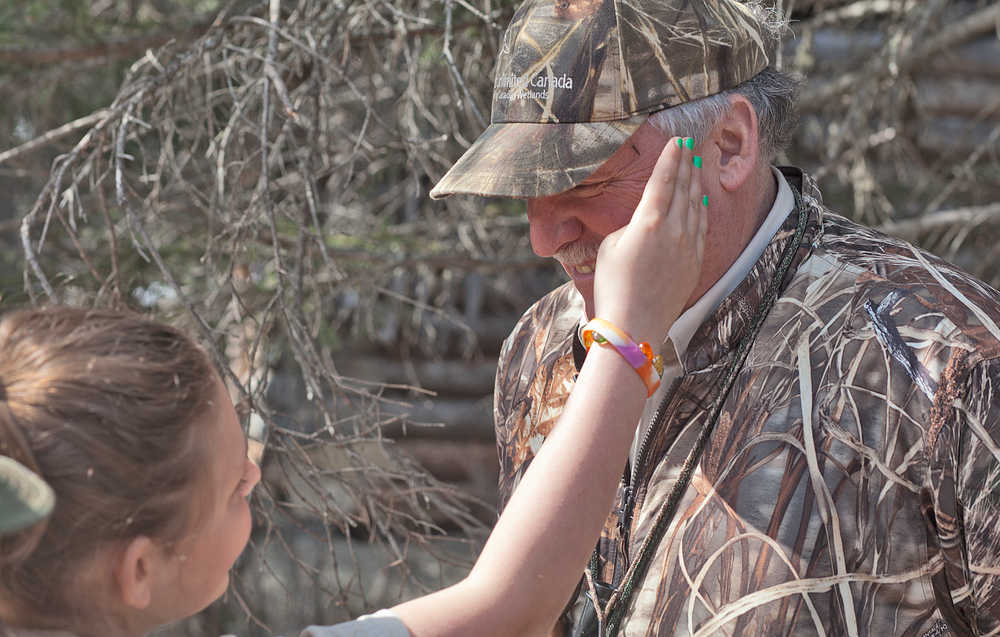Editor’s note: This story has been corrected to reflect Kelly Modla’s title as a Federal Wildlife Officer.
The sun beat down on Dana Gibson as she lifted a magnet into the air carefully lowered it onto a shotgun shell, her brow furrowing in concentration.
A bead of sweat rolled down the side of her head, as she glanced up at Andy Loranger, Kenai Wildlife Refuge Manager — squinting in the noon sunlight.
“What are you looking for there?” he said.
“I have no idea,” she said. Then she giggled and shrugged her shoulders.
Gibson handed the shells back to Loranger after Dave Bolin, Refuge Operations Specialist at the Alaska Maritime National Wildlife Refuge in Homer reminded her that she was checking to see if Loranger was carrying lead or steel shot with his shotgun.
As a group of fourth and fifth grade students looked on, Gibson and her partner Angus Burke conducted a faux compliance-check on Loranger who was pretending to be a hunter out targeting birds.
They asked for his license, checked his shotgun and questioned him about his pretend day of bird-hunting.
They gave him a pass on carrying one shell with the wrong kind of shot inside of it, but ultimately decided to cite him for having shot one too many Canvasback Ducks in his possession.
Bolin, Loranger’s partner in teaching the enforcement side of a refuge officer’s duties, agreed with the two kids’ assessment of the situation and gave them a few pointers on how an officer would approach a hunter.
Several feed away three dead eagles lay sprawled out on a white folding table as Todd Eskelin, wildlife biologist at the Kenai refuge, spoke to a group of students about their anatomy, finding clues about cause of death and the types of eagles found in North America.
Eskelin hoisted one of the eagles in the air and spread its wings as Jessica Croom stepped toward him, spread her arms and tried unsuccessfully to match the span of the eagle’s wings. Felix Lybarger tried next — but could not stretch far enough to touch the tips of the wings. Still, he grinned up at Eskelin and readjusted his glasses before trying again.
“Aww,” Croom said after everyone in her group tried their hand and came up short. “I was the closest though right?”
Eskelin said the kids shouldn’t be surprised as an eagle can have a wingspan around 7-foot long.
Forty-two kids rotated between six stations set up at the Kenai National Wildlife Refuge headquarters in Soldotna for the first Youth Game Warden camp.
Representatives from the Fish and Wildlife Service, Alaska Wildlife Troopers, Alaska Department of Fish and Game, the U.S. Forest Service, Alaska State Parks and the National Oceanic and Atmospheric Administration took the weekend to teach students about everything from anatomy, archery, boating safety and wildlife forensics to enforcement, conservation and fisheries management.
Several of the teachers travelled to Soldotna from towns across Alaska including Fairbanks, Togiak, Dillingham, King Salmon and Homer.
Kelly Modla, Federal Wildlife Officer from Fish and Wildlife, organized the camp and said she timed it for when the federal wildlife officials were having in-service meetings to ensure that enough teachers would be on hand to keep things running smoothly. The warm weather was a boon for the weekend camp which started at about 9 a.m. on Saturday and will pick up again on Sunday for a few hours before the kids are given a certificate and a commemorative coin, “We got really lucky,” Modla said.
The students were given crash courses in locating lost hikers and identifying birds and big game while learning how refuge managers and enforcement officers do their jobs.
“So, it’s a little bit about biologist, a little bit about management and other ways people enjoy the biology and ecology of these species,” Loranger said. “We focused on hunting and touched on some other reasons that wildlife is important.”
Several officers said they were happy to take a break from their regular duties to educate children.
“I think the kids are obviously excited to be here,” Loranger said. “These kinds of things, where you get to interact with kids, they’re the highlight.”
Bolin, who spends his days as both a management biologist and an enforcement officer said he enjoyed taking a break from answering phone calls and clarifying regulations.
He said he enjoyed watching Gibson role play the position of an enforcement officer.
“We’re showing the kids that sometimes law enforcement is a stressful position,” Bolin said. “This is teaching them what we do and can have a positive effect on our interactions in the future. This is the great part of our job, people are happy to see us and we’re doing stuff for the kids.”
Reach Rashah McChesney at rashah.mcchesney@peninsulaclarion.com

